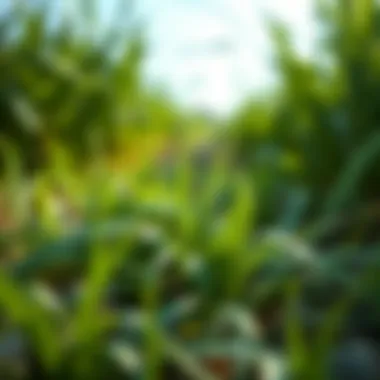Optimal Timing for Crabgrass Killer Applications


Key Insights
Crabgrass, that unwelcome intruder in our lawns, thrives in varying environments, challenging many garden enthusiasts. Understanding when and how to apply crabgrass killer can make or break your struggle against this persistent weed. Timing is not just a matter of urgency, but rather a calculated approach that hinges on the life cycle of crabgrass itself. By observing this lifecycle closely, one can synchronize their herbicide applications effectively to not just manage crabgrass but to mitigate its long-term return.
Crabgrass, from its germination in early spring to its full-grown form in summer, has specific developmental stages during which it is most vulnerable to herbicides. Recognizing these stages is vital. For instance, applying a pre-emergent herbicide before the seeds germinate can significantly help in minimizing the crabgrass population in your yard. Mishaps in timing often lead to ineffective treatments, prompting the need for double efforts and resources.
Importance in Agriculture/Horticulture/Agronomy
The implications of controlling crabgrass extend beyond personal lawns to larger agricultural practices. Crabgrass competes with crops for nutrients and water, leading to subpar yields. In horticulture, the presence of crabgrass can diminish the aesthetic appeal of landscapes, guiding visitors to view poorly maintained gardens unfavorably.
Manually dealing with crabgrass is just like chasing shadows; tackling it at the right moment is key in both urban and agricultural landscapes. Understanding the nuances of crabgrass killer strategies can aid farmers in achieving their production goals while also preserving the ecological balance. It's not merely a matter of aesthetics; optimal timing in treatments can translate into healthier crops and environmentally conscious practices.
Sustainable Practices
Today, there's a growing emphasis on sustainable practices that not only tackle the crabgrass issue but do so in an eco-friendly manner. By integrating practices that ensure minimal damage to beneficial insects and soil health, gardeners can promote a thriving ecosystem within their lawns.
Eco-Friendly Techniques
Using organic or environmentally safe crabgrass killers can be an effective method when applied timely, ensuring that the unwarranted weed doesn't take over. Early spring, before the germination period, is optimal for pre-emergent herbicides like corn gluten meal, which acts not only to prevent crabgrass growth but also enriches the soil.
Furthermore, sowing turfgrass that is shade-tolerant can help naturally block crabgrass seeds from getting the sunlight they need to grow. This is the concept of keeping a healthy lawn—dense turf can outcompete weeds and reduce the need for harsh chemicals.
Case Studies on Sustainability
There are several successful case studies where farmers adopted sustainable crabgrass management practices. For example, a community in Ohio embraced pre-emergent strategies alongside twenty-four-hour moisture monitoring to manage their crabgrass effectively without heavy herbicide use. Through a combination of organic techniques and summer cover crops, they saw not just a decline in crabgrass but a robust improvement in soil quality and overall yields.
Tools & Resources
Navigating the nuances of crabgrass treatment requires the right tools. Accessing these not only improves efficacy but also advances sustainable practices.
Essential Equipment and Technologies
Investing in soil moisture sensors and weather tracking tools can greatly help in determining the optimal moments for applying treatments. Gardening apps can provide local weather forecasts that signal peaks in crabgrass germination cycles, equipping you with beneficial insights that go hand-in-hand with your management efforts.
Recommended Books and Readings
For anyone looking to dive deeper into effective weed management, considering the following resources could prove invaluable:
- Weeds of North America by Michael A. L. Smith and Gary J. Kauffman
- The Organic Gardener's Handbook of Natural Pest and Disease Control by Fern Marshall Bradley
- Turf Management for Golf Courses by James B. Beard
Closure
"A stitch in time saves nine." Taking preventive measures against crabgrass can save considerable effort down the road, making it paramount for every enthusiast to get the timing just right.
For more information surrounding crabgrass management, please visit:
- Wikipedia - Crabgrass
- National Association of Agricultural Educators
- United States Department of Agriculture
- OSU Extension
By incorporating these insights and practices, gardeners can develop an effective strategy for crabgrass management, ultimately creating a flourishing green space.
Understanding Crabgrass
To effectively manage crabgrass, it is vital to understand its biology and behavior in the environment. This knowledge serves as the foundation for timing herbicide applications and implementing management strategies that minimize the weed's proliferation. Understanding the life cycle and characteristics of crabgrass significantly enhances a gardener's ability to control it efficiently and sustainably.
Life Cycle of Crabgrass
Crabgrass, particularly the smooth and hairy varieties, follows a unique life cycle that can complicate its control if not properly monitored. This annual weed typically germinates in the spring when soil temperatures rise above 55°F (about 13°C). At this stage, seeds bury themselves in the soil and begin to sprout when conditions are right, usually during moist periods. Once germinated, the seedlings grow rapidly during warm weather.
Interestingly, crabgrass has a relatively short growing season and is highly adaptive. It produces a profusion of seeds—up to 150,000 from a single plant—ensuring its survival even with considerable control measures in place. By mid-summer, it reaches maturity and its reproductive cycle kicks into high gear. If left unchecked, this can lead to an overabundance of seeds that can lie dormant in the soil for several years, awaiting the perfect conditions to sprout again.
Recognizing this life cycle is key for effective control. For example, applying pre-emergent herbicides just before crabgrass seeds start to germinate can substantially limit its spread by preventing the seeds from sprouting. Additionally, knowing that crabgrass is a summer annual helps to time treatments when it is actively growing, maximizing herbicide efficacy.
Characteristics of Crabgrass


Identifying crabgrass in your lawn is crucial for successful management. It has a few distinctive features that set it apart from other grasses. For one, it typically grows in a sprawling manner, creating a matted appearance with wide blades that can reach up to 12 inches long. The leaves are smooth to touch and somewhat coarse, with a light green tint that may turn a reddish color during hot summer days.
One of its most notable characteristics is its rapid growth rate. Crabgrass establishes itself quickly in warm temperatures, often out-competing desired grasses for sunlight, water, and nutrients. Its ability to thrive in disturbed soils, such as those found in thin lawns or construction sites, makes it particularly troublesome for lawn care.
"Understanding the characteristics of crabgrass can make the difference between a well-manicured lawn and a weed-infested yard."
Furthermore, crabgrass can often be mistaken for other grasses at first glance. Given its coarse texture, you might confuse it with Bermudagrass or some fescues if you aren't careful. As it matures, however, its distinct features become more evident, making it easier to recognize and manage.
In summary, grasping the life cycle and characteristics of crabgrass allows for targeted control strategies. This understanding makes it possible to employ timing methods that are aligned with the weed’s growth patterns, thereby laying the groundwork for effective crabgrass killer applications.
Timing Considerations
Understanding when to apply crabgrass killer is vital for anyone aiming to maintain a healthy lawn. Timing is the key that unlocks success in weed control, particularly for crabgrass, which can quickly overtake a yard if not managed effectively. The delicate balance of nature dictates not only the growth patterns of these pesky plants but also how well herbicides will perform. In this section, we’ll dissect the nuances of seasonal timing, regional variations, and the influence of weather conditions on herbicide application.
Seasonal Timing
Timing your application around the seasons can make all the difference. Crabgrass germinates in the spring as temperatures warm, usually when the soil temperature reaches around 55 degrees Fahrenheit. When this occurs can vary by location, but one thing is certain: the early bird gets the worm, or rather, prevents the weed from taking root.
- Pre-emergence Timing: The ideal time to apply a pre-emergent herbicide is before the crabgrass seeds begin to germinate. This generally happens in early spring. Make sure to apply when the soil temperature consistently hits that 55-degree mark. Remember, timing is everything. If you're a smidge too late, you risk allowing the seeds to sprout and your hard work could be for naught.
- Post-emergence Timing: For those looking to tackle crabgrass that's already popped up, post-emergent herbicides are your go-to. The best time to use these is when crabgrass is actively growing, typically between late spring and early summer. But don't jump the gun; applying when it's stressed from heat or drought can hinder effectiveness.
Regional Variations
The geographical location has its own set of rules when it comes to timing. What works in Florida might not necessarily work in Minnesota. Understanding these regional differences can save you time and effort.
- Northern Areas: In northern climates, you might find yourself dealing with crabgrass as late as June. Applying pre-emergents by mid-April is usually a safe bet. The cooler climate means crabgrass has a slower start, allowing some leeway in timing.
- Southern Areas: In contrast, southern states experience a quicker onset of the growing season. Therefore, as early as March, you might need to apply your pre-emergent to get ahead of the game. The faster the soil warms up, the faster your response time should be.
This regional variability demonstrates that a one-size-fits-all approach simply doesn’t cut it. Use your local extension services or university resources to gauge the best practices in your area, ensuring you stay ahead of the curve.
Weather Conditions
Weather plays a pivotal role in the success of your herbicide applications. Conditions can change at the drop of a hat, and being prepared for those shifts is essential.
- Moisture Levels: After application, light rain can be beneficial as it helps to activate the herbicide. However, if heavy rains are forecasted after application, hold off; excessive water can wash away the product, leading to ineffective treatments.
- Temperature Extremes: Extreme heat or cold can affect the herbicide’s efficacy. Crabgrass generally thrives in warmer weather, but scorching heat may stress the plant, making it less susceptible to herbicides. The sweet spot usually falls between 60 to 80 degrees Fahrenheit for effective application.
- Humidity: The humidity level can also sway results. A very humid environment after application might increase absorption, yet it can also lead to runoff if rains follow shortly thereafter.
By observing these weather elements closely, you can time your applications to hit that sweet spot, leading to more efficient weed control.
Types of Crabgrass Killers
Choosing the right type of crabgrass killer is pivotal in managing this persistent weed effectively. Each type serves a distinct purpose and is best suited for a specific stage of crabgrass growth. Understanding the differences between pre-emergent and post-emergent herbicides, along with natural alternatives, can furnish you with the tools needed for tailored lawn care. The focus here lies not just in the application, but in optimizing results while considering environmental impacts and grass type compatibility.
Pre-emergent Herbicides
Pre-emergent herbicides are characterized by their function; they prevent crabgrass seeds from germinating. These herbicides create a chemical barrier in the top layer of soil, intercepting the sprouting seeds before they ever make their way above ground. Timing is crucial – applying these treatments too early or too late can lead to failure.
Typically, the best time to apply pre-emergent herbicides is in early spring, just when the soil temperature reaches about 55°F (13°C) for consecutive days. This temperature often aligns with your local forsythia blooms, which serves as a reliable natural indicator of the right moment.
Important benefits of pre-emergent herbicides include:
- Weed Control: They halt crabgrass before it takes hold, simplifying later maintenance.
- Long-lasting: Many formulations provide protection for several weeks, reducing the need for multiple applications.
- Diverse Products: Options are available to cater to specific lawn types and conditions, whether you’re dealing with sandy soils or heavier clay mixes.
However, it’s essential to be aware that these herbicides might also affect desirable grass seed. Therefore, it's wise to check compatibility with your grass type and apply according to label instructions.
Post-emergent Herbicides
Unlike their pre-emergent counterparts, post-emergent herbicides tackle crabgrass that has already emerged. These products are designed to kill existing weeds in your lawn, making their application necessary if the crabgrass has already made itself at home.
The best time to use post-emergent herbicides is in late spring to early summer when crabgrass is actively growing. A few considerations are vital here:
- Know Your Weeds: Identifying the right type of crabgrass is critical; some products may perform better on certain species.
- Weather: Aim for a calm day when the temperatures are not excessively hot to avoid damaging your grass. Optimal application oftentimes is when temperatures hover between 65°F and 85°F (18°C to 29°C).
- Application Technique: Spray evenly over the affected areas for best results, and consider using a surfactant to enhance the absorption of the herbicide.
Despite their effectiveness, using post-emergent herbicides demands caution as they could injure your grass if not applied properly.
Natural Alternatives
For those leaning towards eco-friendly methods, several natural alternatives can be effective in managing crabgrass. While they might not produce instantaneous results like chemical herbicides, these options provide a lower-risk approach to weed control.


- Vinegar: A household item that is surprisingly effective due to its acetic acid content, vinegar can destroy young crabgrass. However, it may also affect surrounding plants, so application should be targeted.
- Boiling Water: Pouring boiling water directly onto crabgrass can serve as a destructive method, ideal for small patches.
- Corn Gluten Meal: This natural pre-emergent herbicide inhibits seed germination. It's particularly beneficial as a long-term strategy, but requires specific timing for effectiveness.
"The key to a thriving lawn often lies in understanding the balance between efficiency and environmental impact."
Natural methods demand more effort and patience, but they offer a sustainable solution for lawn enthusiasts interested in preserving ecological integrity.
In summary, understanding the various types of crabgrass killers and their specific uses can significantly improve your lawn care regimen. Each category has its merits and ideal usage scenarios, making it essential to select the right one according to your unique lawn conditions and maintenance goals.
Best Practices for Application
When it comes to applying crabgrass killer, executing best practices is essential. It not only maximizes the effectiveness of the herbicide but also minimizes potential harm to the surrounding environment and other plants in your yard. This section explores the significance of proper application methodologies, key techniques, and necessary tools required for success in crabgrass management.
Application Techniques
Implementing the right application techniques can be the difference between a lush, healthy lawn and a crabgrass-ridden nightmare. Here are several effective methods to consider:
- Spraying: Utilizing a sprayer can allow for even distribution. A backpack or hand-held sprayer is often best for smaller areas, while a tank sprayer works well for larger lots.
- Granular Application: Granular herbicides can be spread using a broadcast spreader. This can help ensure that product coverage is uniform and minimizes waste.
- Spot Treatment: In cases where crabgrass is limited to specific areas, spot treatments can be effective, reducing unnecessary chemical use. Just apply the herbicide directly onto the targeted weed.
Timing of application is critical; it should be performed on a dry, windless day to prevent drift and ensure maximum absorption into the soil. Additionally, it’s vital to follow recommended rates on the product label; over-applying can lead to adverse effects not only on crabgrass but also on desired grass types as well.
Equipment and Tools Required
Having the right tools at your disposal ensures a smoother application process. Before tackling the project, ensure you have the following items:
- Protective Gear: Always wear gloves, goggles, and a mask to protect yourself from the chemicals in the herbicide.
- Sprayers: Choose between hand-held, backpack, or tank sprayers based on the size of the area you’re treating.
- Broadcast Spreader: For granular products, a broadcast spreader distributes the herbicide evenly and effectively.
- Measuring Tools: Accurately measuring the herbicide can prevent over-application. Use a measuring cup or scales for precision.
Ensuring the right equipment coupled with effective application techniques can significantly boost the overall results in the management of crabgrass.
A thoughtful approach to application techniques and necessary equipment directly influences the control of crabgrass while fostering a healthier lawn. Making informed choices allows for both effective weed management and environmental stewardship.
Factors Influencing Herbicide Effectiveness
Understanding the key factors that influence herbicide effectiveness is vital for anyone looking to tackle crabgrass in their lawns. Without this knowledge, applying any form of treatment might just be like throwing darts in the dark. A variety of elements come into play, namely soil conditions, grass types, and even microclimates. Each of these can significantly affect how well the herbicide performs after application.
When it comes to crabgrass control, it’s not merely a game of spraying and hoping for the best. Instead, precise considerations surrounding these factors can lead to more efficient and effective management strategies. Thus, grasping the underlying principles can elevate your lawn care tactics, making the fight against these persistent weeds much more intentional and successful.
Soil Conditions
The relationship between soil conditions and herbicide effectiveness cannot be overstated. Soil health plays a pivotal role in how well a crabgrass killer works. Healthy, well-aerated soil often contributes to better absorption of herbicides, ensuring they break down properly and reach their targets. On the flip side, compacted or overly dry soils can hinder the absorption process, resulting in diminished effectiveness.
- Soil pH: The acidity or alkalinity of the soil can affect the stability of some herbicides. Most crabgrass killers work best within a certain pH range. A soil pH that’s too high or too low can lead to reduced efficacy, potentially sticking you with stubborn crabgrass.
- Moisture Levels: Adequate moisture in the soil is essential for successful herbicide application. Applying herbicides in overly dry conditions can lead to rapid evaporation, nullifying their effectiveness. Conversely, saturated soils can wash away the herbicide before it has a chance to act.
- Organic Matter: The content of organic matter in the soil aids in herbicide retention. Soils rich in organic matter can improve the retention and decomposition of herbicides, allowing them to act longer and more effectively against crabgrass.
Monitoring these factors can give you a really good edge. Keep a close eye on your soil conditions. A little knowledge goes a long way in ensuring that your efforts do not go to waste.
Grass Type Considerations
The type of grass in your lawn isn't just a decorative choice; it has real implications when it comes to the application of crabgrass killers. Different grass species react differently to various herbicides, which can make all the difference in a successful lawn care strategy. It’s important to match the herbicide's action to the grass being treated, as some formulations can cause more harm than good to certain grass types.
- Cool-Season Grasses: If you grow species like Kentucky bluegrass or fescue, they often respond differently to treatments compared to warm-season grasses. Using a herbicide suited for cool-season grasses can keep your landscape thriving during its peak growing season.
- Warm-Season Grasses: Conversely, grasses like Bermuda or zoysia thrive in warmer conditions but may require more specific formulations for effective crabgrass control. Using a herbicide designed for these species can minimize damage and promote healthy growth.
- Tolerance Levels: Each grass type has its tolerance levels concerning herbicide application. Some grasses may tolerate certain treatments without a hitch, while others may suffer severe damage. Knowing your grass type can influence not just what herbicide to use, but when to apply it as well.
In summary, the right crabgrass control strategy hinges not just on timing but also on understanding both your soil and your grass type. With this comprehension in mind, you're not merely hoping for the best; you're ensuring a well-fought strategy for managing those pesky weeds effectively—because no one wants crabgrass stealing the spotlight from a well-maintained lawn.
Soil and grass type are two fundamental elements that, when understood, empower you to make the right decisions in herbicide application.
Monitoring and Follow-Up
Effective management of crabgrass doesn't just stop at application. Once you've put your plans into action, monitoring and follow-up become crucial steps in maintaining a healthy and crabgrass-free lawn. This phase is not just an afterthought; it’s integral to ensure that your efforts bear fruit. By carefully tracking the performance of the herbicide and making adjustments as necessary, you can significantly enhance your outcomes.
Assessing Herbicide Impact
After you’ve applied the crabgrass killer, the next sensible step is to evaluate its impact on both crabgrass and the surrounding environment. Assessing herbicide impact can involve a few key actions. Start by regularly inspecting your lawn to see how crabgrass is reacting. Are the young plants wilting? Check for discoloration or dieback, which can indicate that the herbicide is doing its job.
Keep in mind that the timing of your assessment matters. Performing evaluations too early may give you a false sense of security, while waiting too long could allow the crabgrass to reestablish itself.


To make the assessment more systematic, consider keeping a journal where you note your observations about crabgrass presence over time. Include things like:
- Date of the initial herbicide application
- Weather conditions during the application phase
- When you see signs of effect (or lack thereof)
This meticulous approach provides valuable data that could inform future applications, helping you to refine your technique and improve results. For more in-depth knowledge on herbicides and their impacts, visit Wikipedia.
Timing for Reapplication
If the initial application doesn’t achieve the desired results, timing for reapplication becomes a key consideration. Reapplying too soon can risk damage not only to the crabgrass but also to desirable grasses. Adhere to the manufacturer’s guidelines concerning reapplication intervals, as these can vary based on the chemical formulation used.
Timing plays a critical role here. Typically, subsequent applications might be necessary under a few circumstances:
- Crabgrass Resurgence: If you notice new crabgrass shoots appearing within a few weeks of the initial treatment, a follow-up application may be needed.
- Inefficient Kill Rates: If your assessment shows enduring patches of green crabgrass, it’s possible that the original herbicide lacked efficacy due to environmental factors.
In general, aim to observe the lawn's condition closely for any signs of crabgrass making a comeback. Mark your calendar for scheduled evaluations, allowing you to tackle the problem before it spirals out of control. This back-and-forth of monitoring and adjusting may seem tedious, but it pays off in a well-kept lawn.
Keeping up with these practices ensures a proactive approach to crabgrass management, using monitoring as a tool to reinforce your initial efforts and foster a thriving, healthy lawn.
Integrated Pest Management Strategies
Integrated Pest Management (IPM) refers to a holistic approach to managing pests and weeds, combining various strategies to minimize environmental impact while effectively controlling threats like crabgrass. Understanding IPM is crucial for farmers and lawn care enthusiasts who wish to adopt sustainable practices in their weed management.
Key Elements of Integrated Pest Management:
- Prevention: Focus on preemptive measures, like maintaining a healthy lawn through proper fertilization, watering, and mowing, to create an unwelcoming environment for crabgrass.
- Monitoring: Regularly check for crabgrass growth by observing lawn patterns and identifying early signs of infestations.
- Control Strategies: Utilize a combination of cultural, mechanical, and chemical approaches tailored to specific conditions.
- Evaluation: After implementation, assess if the chosen methods have been effective in minimizing crabgrass populations, adjusting techniques for future applications as needed.
There is a significant attention to not merely eradicating crabgrass but creating balance within the ecosystem. This balance encourages beneficial organisms that can outcompete crabgrass, as "an ounce of prevention is worth a pound of cure.”
In summary, adopting integrated approaches not only fights crabgrass but also supports overall lawn health, making it a vital aspect of modern lawn care strategies.
Cultural Control Methods
Cultural control methods are foundational practices designed to create a yard environment that is less favorable for crabgrass and other weeds. These methods do not solely rely on chemical herbicides; instead, they influence the growth conditions of the lawn.
For instance, mowing at the proper height is a simple yet effective technique. Keeping grass at a height of around 3 inches helps shade the soil, making it harder for crabgrass seeds to germinate. Similarly, applying fertilizers appropriately contributes to a robust lawn that can naturally suppress weed growth.
Other cultural methods include:
- Diversity: Planting a mixture of grass species can effectively outcompete weeds, as different species have varying growth rates and requirements.
- Soil Management: Ensuring optimal soil health through aeration and appropriate pH can foster strong grass growth while inhibiting crabgrass development.
Emphasizing cultural practices can transform your lawn into a thriving ecosystem, deterring not only crabgrass but many potential weed problems.
Mechanical Control Approaches
Mechanical control methods involve physically removing crabgrass or preventing it from overtaking your lawn. This can range from simple hand-pulling to more involved processes. While labor-intensive, these methods can be quite effective, especially for small infestations.
Some mechanical strategies include:
- Hand-Pulling: Best done when the soil is moist, allowing for easier extraction of the entire root system. This method directly reduces crabgrass populations without chemical use.
- Tilling: For larger areas, tilling the soil can disrupt the lifecycle of crabgrass. Be cautious though; tilling can also bring dormant seeds to the surface, potentially worsening the problem if not monitored.
An additional approach worth mentioning is the use of landscape fabric, an effective barrier around garden beds, which can help suppress crabgrass by blocking sunlight from reaching weed seeds.
Utilizing mechanical control methods can provide immediate relief in conjunction with cultural practices, creating a more comprehensive strategy that doesn’t rely heavily on chemicals and promotes healthier living conditions for your lawn.
Closure
Effective crabgrass management is not just about killing a weed; it’s about fostering a vibrant lawn ecosystem.
Recap of Key Points
The discussion covered key elements fundamental to optimal timing when applying crabgrass killers:
- Understanding Crabgrass Life Cycle: Recognizing the growth phases of crabgrass aids in choosing the right moment for treatment.
- Environmental Influences: Local weather, soil conditions, and seasons can significantly impact the efficacy of herbicide applications.
- Herbicide Types: Differentiating between pre-emergent and post-emergent herbicides allows for tailored approaches based on the timing and growth stage of the crabgrass.
- Monitoring Outcomes: Continuous observation of herbicide effects and the timing for reapplication ensures ongoing control of this persistent weed.
Final Recommendations
In light of all the information discussed, here are some final pointers to consider:
- Timing is Everything: Always apply pre-emergent herbicides before the crabgrass germination window opens. For post-emergent products, target younger, actively growing crabgrass for optimal results.
- Local Climate Matters: Stay attuned to local weather patterns and soil conditions to fine-tune your application schedules.
- Utilize Integrated Approaches: Combine chemical treatments with cultural and mechanical methods for a holistic strategy to lawn care.
- Observe and Adjust: Regularly monitor your lawn. If crabgrass persists, reassess your application timing and techniques.
By internalizing these strategies, agricultural farmers and enthusiasts can cultivate not only a beautiful lawn but also a more resilient ecosystem.







